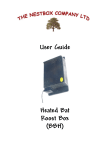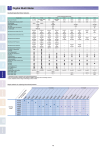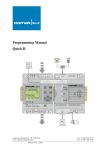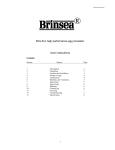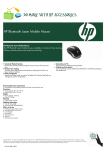Download User Guide Advanced Wireless Camera Kit (K2)
Transcript
User Guide Advanced Wireless Camera Kit (K2) from the Enjoy Birds More range of wildlife watching products Page 1 Contents Section 1. 2. 3. 4. 4.1 4.2 4.3 4.4 5. 5.1 5.2 5.3 5.4 5.5 5.6 6. 7. 8. Page 2 Topic Page Introduction . . . . . . . . . . . . . . . . . . . . . . . . . . . . . . . . . . . . . . . 1 Setting Up Your Equipment and System . . . . . . . . . . . . . . . . . 1 Unpack and Familiarise Yourself With Your Kit. . . . . . . . 2 Setting Up Your Equipment for Operation. . . . . . . . . . . . . . . 2 Fit the Circuit Board in Your Nest Box . . . . . . . . . . . . . . . . . . . 2 Connect up the Nest Box and Electronic Battery Box . . . . . . . . 4 Set up the Receiver and Connect to TV. . . . . . . . . . . . . . . . . . 5 Fit Nest Box in Garden. . . . . . . . . . . . . . . . . . . . . . . . . . . . . . . . .6 Miscellaneous. . . . . . . . . . . . . . . . . . . . . . . . . . . . . . . . . . . . . . 6 Use of the Mode Control Switch. . . . . . . . . . . . . . . . . . . . . . . . 6 Adjustment of Lighting System and Focus. . . . . . . . . . . . . . . . 7 Audio Volume . . . . . . . . . . . . . . . . . . . . . . . . . . . . . . . . . . . . . . . 9 Transmission Range. . . .. . . . . . . . . . . . . . . . . . . . . . . . . . . . . . 9 Cleaning the Nest Box. . . . . . . . . . . . . . . . . . . . . . . . . . . . . . . . 9 Mains Power Supply . . . . . . . . . . . . . . . . .. . . . . . . . . . . . . 10 Specifications, Warranty etc. . . . . . . . . . . . . . . . . . . . . . . . . . . 10 Care for the Environment . . . . . . . . . . . . . . . . . . . . . . . . . . . . . . 11 Accessories for your Kit . . . . . . . . . . . . . . . . . . . . . . . . . . . . . . . 12 1. Introduction Thank you for purchasing one of the Nestbox Company’s family of products. We hope you will enjoy many years of viewing wildlife with this camera kit. 2. Setting Up Your Equipment and System The Advanced Wireless Camera Kit consists of 3 main components: 1. Camera / Electronics / Transmitter 2. Electronic Battery Box 3. Receiver As well as this, it includes everything necessary to connect the parts of the system together, to power sources, and to your computer or TV. It is easy to put the system together by following these step by step instructions. Page Page 31 3. Unpack and Familiarise Yourself With Your Kit As well as this User Guide, you should have the following parts: Circuit Board with Camera, with cable to connect to Battery Box, and 4 mounting pillars Electronic Battery Box, including mode switch and battery holders. Mains power supply for Battery Box (Internal Use Only). This provides an optional alternative to running the system on batteries. Receiver, with Antenna, mains Power Supply and Video/Audio Lead to connect between the Receiver and TV. 4. Setting Up Your Equipment for Operation 4.1 Fit the Circuit Board in your Nest Box The Circuit Board should be fitted so that the camera (which can be swiveled and tilted on its bracket) can “see” the nesting area, and so that the movement sensor will “see” movement within the box, and the light sensor can respond to light levels within the nest box. Often this means fitting it to the roof of the nest box. Page Page24 The Circuit Board can be secured in position by making mounting grooves in your box, or using the mounting holes in the 4 corners of the board. These mounting holes are approximately 4mm diameter, and have centres approximately 47mm and 113mm apart (see picture below). You can screw through these holes into appropriate projections in your nest box, or use the mounting pillars to fit the circuit board to the top or side of your nest box. The pillars can be fitted by drilling 4mm holes in the top/side of the box, and pushing the “T” end of each pillar into this hole. The Circuit Board can then simply be snapped onto the projecting ends of the 4 pillars. Page Page 35 Example showing Circuit Board fixed to the roof of a nest box 4.2 Connect up the Nest Box and Electronic Battery Box Cable from Nest Box Goes here Cable from Mains Power Supply Unit Goes here Cables from Solar Panels Or Wind Generators Go here Plug one end of the black cable into the black socket on the camera Circuit Board. Check that the camera is pointing towards the nesting area, and then run the cable out of the nest box. Open the front of the Electronic Battery Box. If you plan to use the system on batteries, fit 8 size “D” batteries into the battery holders (observing the polarity marked on them), Do not use the connector marked with a yellow sleeve. Connect the other end of the cable coming from the Nest Box to the socket on the underside of the circuit board. If you plan to power the system using the mains power supply, do not put batteries into the battery holders, but instead connect the PP3 connector on the mains power supply to the mating PP3 connector marked with a yellow sleeve. Page Page46 The Battery Box is already equipped to use solar panels and/or wind generators, which simply connect to the small white connectors in the Electronic Battery Box. Route all the cables entering the Battery Box through the cable slot in the base of the box. Secure the front of the box using the 4 plastic pegs (which should be inserted fully, and then turned 90⁰ with a screwdriver to lock). 4.3 Set up the Receiver and Connect to TV Screw the Antenna onto one end of the Receiver. Adjust the angle of the Antenna so that it is approximately vertical. The receiver can be mounted vertically using the screw holes provided, or rested in a horizontal position. Adjust the angle of the Antenna so that it is approximately vertical. SCREW ANTENNA ONTO RECEIVER Fit the 9V Mains Power Supply (it has a cylindrical plug) to the Receiver (DC 9-12V) and plug it into the Mains. Switch the power on. The red indicator light will show it is on. Fit one end of the Receiver Video/Audio Lead to the Receiver, connecting yellow to “VIDEO OUT” and white or red to “AUDIO OUT”. Fit the other end of the Receiver Video/Audio Lead to the direct input video/ audio of your TV. Connect yellow to video in, and white or red to an audio in socket. As an alternative, you may prefer to fit this in to the Video/Audio connectors on a video recorder or VCR. If you only have a SCART input socket for your TV, you can fit the cable through an appropriate adaptor (available from our accessories range). The cable (and the signal it carries) is not suitable for direct connection to your TV aerial or antenna socket. Turn the TV on, and switch it to the direct video/audio input. Page Page 75 Move the switch on the Battery Box to the CONT position. Set the Channel Switch on the Receiver to the channel number indicated by the label on the top of the camera. You should see the inside of your nest box on your TV screen, and hear through the TV if you tap the box or gently blow on the camera. If you didn’t notice which channel it was set to, simply move the switch in turn to each of the 4 channels until you see the picture. Adjust the camera angle so that the picture covers the area where the birds will nest. 4.4 Fit Nest Box in Garden You are now ready to set up the nest box and battery box in the garden. Your nest box should be fitted in a position where it is close enough to the Receiver so that you get a good picture. Although the nominal range is 100 metres, the actual range depends on a number of factors, particularly including obstacles close to and in between the nest box and the Receiver, such as walls and trees. If you are in any doubt as to the position, it may be better to fix the nest box temporarily until you have checked the reception. Run the cable down the tree or wall, to the Battery Box, which should be fitted in a convenient location for changing batteries and reaching the control switch. The Battery Box can be mounted onto a wall or tree etc using just 1 nail or screw and the mounting bracket at the rear of the Battery Box. If preferred, it can alternatively be mounted using up to 4 screws through the concealed mounting holes which are visible when the front of the box is removed. 5. Miscellaneous 5.1 Use of the Mode Control Switch The switch on the front of the Battery Box has 3 positions: “STD” Standard In this mode, the movement detection system monitors the inside of the nest box for movement of the birds. If movement is not detected for a prolonged period, the nest box electronics will be partially shut down to save battery power. When movement is detected again, the system will switch back on and transmit pictures and sound to the receiver. Page 8 Page 6 Whilst partially shut down, neither video nor audio is transmitted from the box. Your TV will either show a still picture or “snow”, depending on which TV you have and the precise instant when the shut down occurred. You will lose sound, so may wish to press “mute” when this occurs. Please remember that because the electronics are designed to work with live birds, the detection system is not 100% accurate. The movement sensor system may sometimes be triggered by insects or air movement, and sometimes will not trigger when there is movement. To avoid “jitter”, it is designed to wait a few seconds each time it switches before it will switch again. This setting is designed to give a long battery life, depending on how much movement there is in the box. Central Position, “OFF” This position provides power to the electronics, but switches off the lighting, microphone, camera and transmitter. It hardly takes any power, so the batteries should last a very long time in this position. “CONT”, Continuous This setting puts all the systems within the box on continuously, and will take the most power out of the batteries. This is suitable when you want to be sure that your picture is not interrupted when there is no movement, perhaps because you are recording a video. Naturally, the batteries will not last as long with this setting, so you may prefer to use the mains power supply if you plan to operate on this mode for long periods. 5.2 Adjustment of Lighting System and Focus Before leaving the factory, the camera focus has been adjusted to approximately 150mm (6 inches). You can adjust the camera focus by turning the lens turret. The camera is a very delicate part of the system so please do this gently, and be very careful not to touch a finger on the lens. The lighting system has 3 “states” or modes of operation, and whenever it is switched on, it will always be operating in one of these 3 states. State 1: High level: when bright external or natural light reaches inside the nest box, the internal lights are switched off. Page Page 79 State 2: Daylight: whenever the lighting system is switched on, but the camera needs some additional light to provide a good picture, and the external light is bright enough to indicate it is daytime, a supplementary white light is switched on. State 3: Night time: whenever the lighting system is switched on, and the external light is dim enough to indicate it is night time, a supplementary infra red light is switched on. This is largely invisible to human and bird eyes, so does not disturb the birds’ natural rhythms. Although the camera continues to give a colour picture, this form of illumination means that the TV picture looks as if it consists largely of shades of grey. The points at which the lighting system switches between different states has been factory set to correspond to average conditions. However, if your box is in a particularly open, or shady location, or for some other reason, you can change this setting as follows: Daylight / Night Time (State 2 to State 3) 1. 2. 3. 4. 5. 6. 7. 8. Choose a time when the light level outside is the level at which you want the system to switch. Start with the system in the “OFF” state. Turn it to “CONT”, and then immediately back to “OFF”. The system should now be in “set” mode and the white light inside the box should flash on and off 6 times to show it is waiting for you to set the switching point. If you don’t get 6 flashes, try from step 2 again. Wait until after the 6 flashes, check that the light level is the level at which you want it to switch every morning and evening, and then switch back to “CONT”. Leave the system in this state for at least 30 seconds. It will now have saved this setting until you set it again. You can now switch off or on as normal. Daylight / High Level (State 1 to State 2) 1. 2. 3. 4. 5. 6. 7. Choose a time when the light level outside is the level at which you want the system to switch. Start with the system in the “OFF” state. Turn it to “STD”, and then immediately back to “OFF”. The system should now be in “set” mode and the white light inside the box should flash on and off 3 times to show it is waiting for you to set the switching point. If you don’t get 3 flashes, try from step 2 again. Wait until after the 3 flashes, check that the light level is the level at which you want it to switch, and then switch back to “STD”. Leave the system in this state for at least 30 seconds. It will now have saved this setting until you set it again. Page Page810 8. You can now switch off or on as normal. If you accidentally switch the system into “Set” mode, and at any point you get either 3 or 6 flashes, disconnect the nest box from the battery box by pulling the plug out of the socket in the Battery Box. This will avoid resetting the switching points. The Camera is very sensitive to light, as it is designed to work in the dark interior of a nest box. Because of this, (depending on how large your nest box is) you may find that the lights (which have their own lenses built in to focus the light on the nesting area) are a little too bright for the camera, when pointing straight onto the nesting area. You can tell if this is the case, because you will notice circular rings of brighter light in the picture. If you experience this effect, simply carefully bend the wire legs of the lights to point slightly away from the nest area, so that they light the general area within the nest box. 5.3 Audio Volume The audio system is fitted with an Automatic Gain Control (AGC) which increases the amplification when the microphone is picking up little sound, and decreases it when it picks up more noise. In quiet situations, this results in high gain, and can result in what sounds like a steady hum. We suggest you set the volume on your TV or PC to a level where in quiet conditions, any background noise or hum is barely audible, and is not intrusive. When the birds take up residence, and start making a noise, the AGC will ensure that you hear their sounds well above the level of the background noise. 5.4 Transmission Range The Transmitter and Receiver have a nominal range of 100 metres. The actual distance achieved will vary depending on atmospheric conditions, the position and type of nearby obstacles (such as walls, trees, or metal objects) and the state of the batteries. Moving the Receiver just a few centimetres can sometimes make a big difference to the strength of the signal, so to obtain the best reception, we suggest you move the Receiver around to find the best location by trial and error. 5.5 Cleaning Once a year, after the nesting season has finished and all the birds have left the nest, we recommend that you clean out the nest box and dispose of all nesting material and unhatched eggs etc. Under UK legislation, you can only remove unhatched eggs between August and January, and then must dispose of them. Page Page 911 To do this, remove the Circuit Board and carefully clean it with a soft cloth or brush, being especially careful with the camera lens and electronics. Take out any nesting material and throw it away, and wash out the box. With the box open, leave it for a day or two to dry out, before refitting the Circuit Board, and putting the box back in position. The Battery Box will also benefit from an annual clean, and it will be worth using a small brush to remove any insects and debris from the box, electronics and battery holders. 5.6 Mains Power Supply The outside components of your system are designed to be used on battery power, but if it is convenient, you may prefer to use mains power. The mains power supply which is included is designed for interior use only. It is intended to be plugged into an internal socket on a fused 13A electricity supply, with the lead running outside to the Battery Box. IT IS DANGEROUS TO FIT IT OUTSIDE OR IN A DAMP ATMOSPHERE. The cable (which operates at low voltage) is safe to use outside. If you need to extend this cable, this can be done with the “Mains to Battery Extension Cable”, product A35. To use mains power instead of batteries, remove the batteries. Fit the PP3 connector on the end of the cable from the mains power supply to the mating connector marked with a yellow sleeve. Inside the Battery Box A set of 8 new size “D” alkaline batteries will power the camera on “STD” setting for between 10 days and 7 months, depending on their capacity, activity in the nest box and the transmission path. If you prefer to use rechargeable batteries or solar or wind power to operate the nest box on batteries, these are available from our comprehensive range of accessories. 6. Specifications, Warranty etc The specifications of the product described and the contents of this User Guide are subject to change without notice, as part of our continuous improvement process. Whilst every care has been taken in the preparation of this document, we realise that it will still be possible to improve it. If you find any errors, omissions or points which are not clear, or have any suggestions for improving it, please let us know by email at [email protected]. We will endeavour to deal with any problem to your satisfaction, and learn from it for future versions. The contents of this document may not be reproduced in whole or in part except for your personal use. Page Page1012 The Nestbox Company Limited warrants all its products against defects in materials and manufacture for 6 months from the date of purchase. If a defect is discovered, The Nestbox Company will repair or replace the product (at its option) free of charge, provided it is returned to the address in this User Guide at the customer’s expense. The Nestbox Company Limited is not able to accept any responsibility for any loss, damage, or loss of data suffered by any customer or third party as a result of use, misuse or malfunction of the product or this User Guide. In particular, whilst the product has been extensively tested, we are unable to warrant that is error free. If you have a further technical or user question relating to the product, please email it to us at mail.nestbox.co.uk. From time to time, we provide customers with product updates. Please check the web site for details. 7. Care for the Environment As you might expect, The Nestbox Company cares deeply about the Environment. We have adopted an Environmental Policy designed to demonstrate our commitment to operating our business in harmony with the natural and man made environments. If you wish to see the full policy, it is available to read on our web site. Our products are developed to be economical with natural resources, both in manufacture and use. We comply with the relevant laws and regulations, including those relating to the Restriction of Hazardous Substances (known as RoHS) and Waste Electronic and Electrical Equipment (WEEE). The wood used in our products comes from responsibly managed forests, as part of our commitment to the Forest Stewardship Council. When you have finished using this product, please dispose of it responsibly. Please separate it from other household waste or recycling, and use a local facility for waste electrical and electronic equipment. This User Guide is printed on recycled paper. Page Page11 13 8. Accessories for your Kit Our comprehensive range of accessories is designed to enable customers to make the best use of their purchase. Why not accessorise your equipment to extend its capabilities and make it do exactly what you want? The following examples of our accessories may be of interest: Control / Battery Extension Cable (A34) Extend the distance from the Battery Box to the Nest Box. Mains to Battery Extension Cable (A35) Want to use mains power, but need a longer cable from the mains power unit to your battery box ? This is what you need. Connection to PC/Laptop (A37) This small converter allows you to feed pictures from your camera straight into your computer. No need to install any hardware inside the computer. Rechargeable High Capacity Battery Set (A40) 8 high capacity rechargeable batteries. Last for longer between charges. Solar Panel (A41) Help save the planet by using renewable energy to operate your camera. You may never need to change the batteries again. Wind Generator (A42) Free energy to supplement solar or mains recharging for your camera. Good looking and discreet generator. You can find the full range of accessories on our web site, www.nestbox.co.uk, or just scan the QR code here: Page Page1214 Did you know we produce an extensive range of nesting boxes for birds and small mammals, and feeders and insect boxes? We also make a wide variety of Camera Nest Boxes, and Wildlife Cameras and Accessories? Some of our products: Wildlife Camera (C10) A sophisticated remote video camera for watching wildlife. Use it wired or wireless, day or night. Complete with its own sophisticated electronic battery box. Wireless Camera Nest Box (B1) A full function Wireless Camera Nest Box, but with simpler electronics. Small translucent window gives colour pictures in daylight , while infra red lights give pictures at night. Mains or battery operation To order, or for more details of all our products: Visit us at www.nestbox.co.uk, Email us at [email protected] Telephone us at +44 (0) 1675 442299 Or scan the QR code : Page 15 The Nestbox Company Limited Eastcote House Barston Lane Eastcote Solihull West Midlands B92 0HS UK Telephone: +44 (0) 1675 442299 Fax: +44 (0) 1675 442421 Web site: www.nestbox.co.uk Email: [email protected] This publication, our products and our designs are © Copyright 2012 The Nestbox Company Limited and protected by UK Patent 2420242 All our products are tested for compliance with the relevant directives, and carry the CE Mark WEEE Producer Registration Number WEE/HB0002ZR Battery Producer Registration Number BPRN00576 Page 16
















